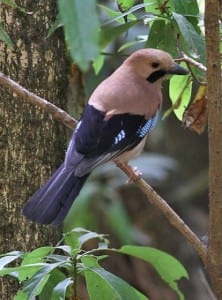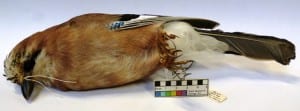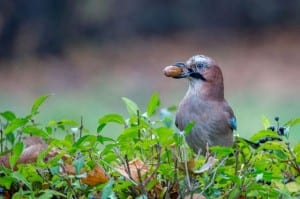Specimen of the Week 174
By Dean W Veall, on 9 February 2015
 Hello dear readers, Dean Veall here. I came across this week’s Specimen of the Week whilst writing another Specimen of the Week many months back and thought I would save it for a cold February Monday as just like that specimen it has a irrescedent sparkle on its wings that will hopefully banish those Monday blues. It is also a species that many of us will have likely come across as we have peered whistfully out of our windows whilst writing romantic prose (no? Just me) in Winter when this species stands out the most. If you did spot this species as you were looking out the window on the last weekend of January you were probably one of 315,000 who were taking part in the RSPB’s Big Garden Birdwatch. *Spoilers* With that tidbit I should probably tell you that this week’s Specimen of the Week is…….
Hello dear readers, Dean Veall here. I came across this week’s Specimen of the Week whilst writing another Specimen of the Week many months back and thought I would save it for a cold February Monday as just like that specimen it has a irrescedent sparkle on its wings that will hopefully banish those Monday blues. It is also a species that many of us will have likely come across as we have peered whistfully out of our windows whilst writing romantic prose (no? Just me) in Winter when this species stands out the most. If you did spot this species as you were looking out the window on the last weekend of January you were probably one of 315,000 who were taking part in the RSPB’s Big Garden Birdwatch. *Spoilers* With that tidbit I should probably tell you that this week’s Specimen of the Week is…….
**The Eurasian Jay (Garrulus glandarius)**
1). Colourful Corvid
The Eurasian jay is on the colourful side of the corvid family, not as garish as the Sri Lankan blue magpie, but still more colourful than the other members of the group that includes rooks, ravens, crows, jackdaws and magpies. The jay is the most widespread of all corvids ranging from the far reaches of western Europe and north-west Africa to the coasts of Asia and India. This vast range has had an evolutionary effect on this species, especially at the extremes of its range, there have been identified five racial forms that can be quite distinct from each other. In total there are 33 sub-species within these five forms. The subspecies of the Eurasian jay is divided according to locality and each of these groupings have distinctive markings associated. For example, the Bispecularis group are characterised by an immaculate crown of pinkish feathers and is found from the western Himalayans to Taiwan. Our specimen has the marking of the Glandarius group, a pink-ish brown overall body colour, white rump, irredescent stripes of blue along the wing and striped black crown which relates to the location it was found according to our records in Quex Park, Kent.

Eurasian jay Bispecularis groupimage taken by Jerzystrzelecki obtained from http://commons.wikimedia.org
2). Oaks and jays
Like the majority of other corvids the Eurasian Jay is an opportunistic feeder with an omnivorous diet. The majority of its diet is composed of fruits, seeds and invertebrates but this species will also prey upon young birds, bats and small mammals. In one forest in Germany the jay was the main predator of blackcaps, hunting the nestlings during the day and was responsible for a total of 46% of nest losses [1]. If this brutal vision of this friendly garden bird is just too much to handle then I shall hit you (not literally) with the food jays are more closely associated with: acorns. In the Autumn jays collect acorns that will be a food supply that will last throughout the year, these acorns are buried by the jays and come in particularly handy between May and July due to the high demands required for raising their young. The oak trees benefit from their seed dispersal by the jays and this behaviour is a major factor in the regernation of oak woodland [2].
3). Alarming calls
Jays were the subject of a study in 2006 in a park in Germany, that revealed a very interesting relationship they have with red squirrels. Both red squirrels and jays share common predators, the tawny owl, goshawk and pine martin. The study tested whether squirrels will react to the specific alarm calls of jays to the presence of predators using pre-recorded calls. It was demonstrated that squirrels were able to recognise and discriminate these alarm calls from non-threatening sounds and behaved differently compared to their reactions to the other calls that were played to them. They either escaped or were observed to be more vigilant when the sounds were played [2].
4). Using tools
The use of tools are well documented in our closest relatives, apes, but increasingly the use of tools by other animals is becoming better understood. In lab experiments rooks, that have been classified as being non-tool users in the wild were observed using tools to an impressive degree but this had not been investigated in jays before. A team of researchers from the University of Cambridge tested whether jays had a similar ability to use tools as other corvids. When faced with the problem of water displacement to retrieve food, jays showed their ability to use sinkable stones to raise the water level to get the floating meal worms. Apparently they solved this problem with the same ability of a seven year old. Check it out here.
Dean Veall is Learning and Access Officer at the Grant Museum of Zoology
[1] Schaefer, S. (2004) Video monitoring of shrub-nests reveals nest predators: Capsule Jays Garrulus glandarius are the most common predators, but carnivorous mammals and some other species also predate nests. Bird Study. Vol. 51, Iss. 2.
[2] Josep Pons, Juli G. Pausas, Modelling jay (Garrulus glandarius) abundance and distribution for oak regeneration assessment in Mediterranean landscapes, Forest Ecology and Management, Volume 256, Issue 4, 10 August 2008, Pages 578-584
One Response to “Specimen of the Week 174”
- 1
 Close
Close





[…] prep. specimen of the week I have written, having previously written about the kingfisher and the Eurasian jay. Unlike those specimens this specimen excited me because of some recent museum based research that […]